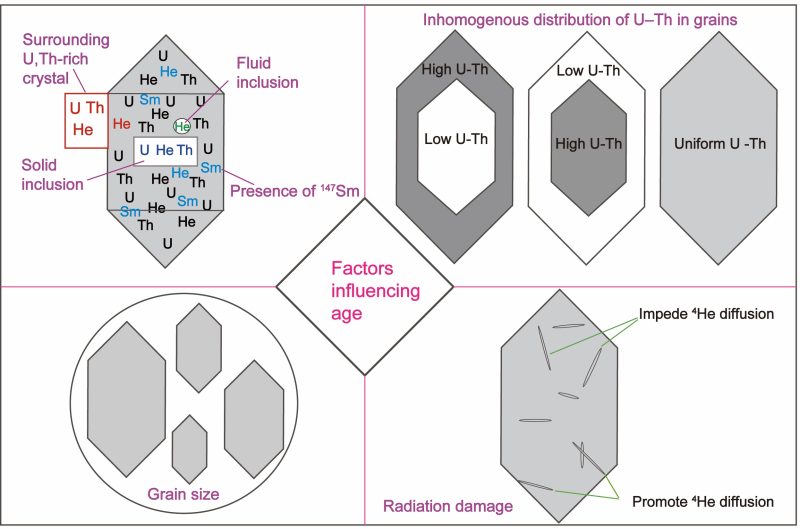
An investigation of factors affecting the reproducibility of (U–Th)/He ages of high- and low-U minerals
ABSTRACT

(U–Th)/He thermochronology is an important tool for resolving the temporal evolution of thermally sensitive geological events, but significant intra-sample variation in single-grain (U–Th)/He ages is commonly observed. Zircon and apatite (U–Th)/He ages from the Jiao-Liao region, eastern China, reveal the factors that affect high- and low-U mineral He ages. Inclusions and surrounding U–Th-rich minerals have little effect on high-U mineral He ages, but do cause scatter in low-U mineral He ages. Improving sample quality is a key way to effectively improve this problem. Time and U content are the decisive factors that affect the function of 147Sm. Radionuclide 147Sm causes variations in low-U mineral He ages, particularly for grains with U <5 ppm and ages >100 Ma. The differences in closure temperature caused by grain size can be minimized by ensuring the difference between the maximum and minimum radius is <30 μm. Representative CL images indicated zircon (U-Th)/He ages are more susceptible to the interference of the internal heterogeneity than apatites. The error due to the alpha particle ejection correction can be neglected when using the laser ablation technique by analysing sites away from grain rims. The effects of radiation damage vary from high- to low-U minerals. Zircon ages show an inverted U-shaped pattern with increasing radiation damage. Radiation damage has a weak positive correlation with apatite He ages, probably due to its low U content. Besides, thermal histories experienced by our samples fail to significantly influence the effect of radiation damage on ages.
KEYWORDS
Keywords: age reproducibility, differential affecting, high-to low-U minerals, influence factors, (U–Th)/He datingSupplementary Materials(file)
https://www.jstage.jst.go.jp/article/geochemj/56/4/56_GJ22008/_supplement/_download/56_GJ22008_1.pdf
- Published : 2022
- Released on J-STAGE : 2022/08/20
- Received : 2022/03/15
- Accepted : 2022/06/19
- DOI : https://doi.org/10.2343/geochemj.GJ22008
- J-STAGE URL : https://www.jstage.jst.go.jp/article/geochemj/56/4/56_GJ22008/_article/-char/en
- J-Online ISSN: 1880-5973
- Print ISSN : 0016-7002
- ISSN-L : 0016-7002
All Issues
- Vol.59, 2025
- Vol.58, 2024
- Vol.57, 2023
- Vol.56, 2022
- Vol.55, 2021
- Vol.54, 2020
- Vol.53, 2019
- Vol.52, 2018
- Vol.51, 2017
- Vol.50, 2016
- Vol.49, 2015
- Vol.48, 2014
- Vol.47, 2013
- Vol.46, 2012
- Vol.45, 2011
- Vol.44, 2010
- Vol.43, 2009
- Vol.42, 2008
- Vol.41, 2007
- Vol.40, 2006
- Vol.39, 2005
- Vol.38, 2004
- Vol.37, 2003
- Vol.36, 2002
- Vol.35, 2001
- Vol.34, 2000
- Vol.33, 1999
- Vol.32, 1998
- Vol.31, 1997
- Vol.30, 1996
- Vol.29, 1995
- Vol.28, 1994
- Vol.27, 1993
- Vol.26, 1992
- Vol.25, 1991
- Vol.24, 1990
- Vol.23, 1989
- Vol.22, 1988
- Vol.21, 1987
- Vol.20, 1986
- Vol.19, 1985-1986
- Vol.18, 1984
- Vol.17, 1983
- Vol.16, 1982
- Vol.15, 1981
- Vol.14, 1980
- Vol.13, 1979
- Vol.12, 1978
- Vol.11, 1977
- Vol.10, 1976
- Vol.9, 1975
- Vol.8, 1974
- Vol.7, 1973
- Vol.6, 1972-1973
- Vol.5, 1971
- Vol.4, 1970-1971
- Vol.3, 1969-1970
- Vol.2, 1968
- Vol.1, 1966-1967




